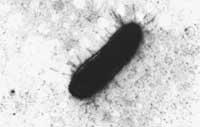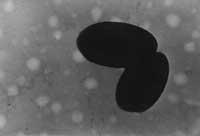Urinary Infection and Escherichia colia
Urinary tract infection is an important public health problem due to its great influence on the population, being more frequent in women than in men.
In reality the urinary tract is sterile, that is, without microorganisms, although occasionally microorganisms colonize this tract and cause infections in humans. The diagnosis of urinary infection consists of the study of urine and the count of microorganisms. If the result of the count is equal to or greater than 105 microorganisms per milliliter, the patient's infection is guaranteed.

In general, urinary infection can be classified into three types: bacteriuria without symptoms, lower tract infection and upper tract infection. The first is very common and the patient is not aware of the infection, since it is suffering without symptoms. Lower tract infections are called cystitis and are also very common; their incidence is exclusive in the urinary bladder and usually have mild symptoms. Upper tract infections, on the contrary, affect the kidneys and are much more serious. They are called pielonefritis and the cases of these infections are minor.
Urinary infections can be caused by different microorganisms, but in most cases, both inside and outside the hospital, the bacterium Escherichia coli is responsible for the urinary infections that are received. This microorganism lives in the human intestine as part of its normal flora, with an important role in maintaining the physiological state of the intestine. On the other hand, some of the strains of this species Escherichia coli have become pathogens, that is, they are able to produce infection, both intestinal and extracenter, being the most important urinary infections.
In most cases, strains E. coli isolated in urinary infections have special characteristics with respect to intestinal strains, being the virulence factors that determine the uropathogenicity of these bacteria. One of the most important virulence factors of the uropathogenic strains E. coli are the hairs P. Due to the anatomy of the urinary tract, it is evident that bacteria from the outside should rise to cause an infection in the urinary bladder and kidneys. Any characteristic that contributes to this increase will become an important factor of virulence since it will facilitate the colonization of the urinary tract for these pathogenic strains. The function of the P hairs of the E. coli strains is to fix bacterial adhesion in the urinary tract so that the discharge of the urine does not expel the bacteria and can continue to rise. However, despite being the most important, P hairs are not the only virulence factors of uropathogens E. coli. Other are hemolisines capable of destroying blood cells, the aerobactin enzyme that facilitates the assimilation of light iron, resistance to antibiotics, encapsulated K antigens, etc.

The aim of this research group in the last ten years has been to analyze the virulence factors of the Escherichia coli bacteria. Virulence factors that help bacteria retain the epithelium of the urinary tract have been studied, including the so-called P hair. Likewise, it has been studied the usefulness of certain antibiotics that can influence the synthesis of these hair, as is the effect of quinolones on the inhibition of the synthesis of the hairs P. Quinolones, used in subinhibitory concentrations, prevent the synthesis of the P hairs of E.coli, preventing the adhesion of bacteria (see photo). Therefore, it has been proven that the use of these antibiotics as a preventive measure in groups of people at risk of urinary infection in the population is an interesting option.
Over the last few years, the progress of the rest of the sciences and, above all, technologies have been changing the techniques used in the investigation of urinary infection. Although initially we used mainly phenotypic techniques to study the characteristics of E.coli strains that produced urinary infections, there are already six years in which we are looking for new applications of genotypic techniques in the investigation of urinary infection. For example, we have adapted a genotypic technique based on PCR (Polymerase Chain Reaction) to agile and easily detect most of the bacterial virulence factors isolated from infected urine in the same test. In this line of work, the method for the direct detection of the virulence factors of E. coli in the urine of the patients was described to avoid bacterial isolation. If it is possible to use this method in the usual work in health centers, we would improve the knowledge of urinary infections that occur in our territory, as well as preventive measures.
- Title of the project: Characteristics of Escherichia coli that cause urinary infection (virulence factors).
- Objective:: Objective: Identify light methods for the study of the bacteria Escherichia coli isolated in urinary infections that occur in our territory and through them investigate the characteristics of the bacteria in the search of preventive measures.
- Financing: Financing: UPV-EHU, Basque Government
- Director: Immaculate Abalia Camino1
- Research team: Elena Rodriguez1, Jose Ramon Bilbao1, Adelaida Umaran2 and Arantxa Sarasua2.
- Department: 1: Nursing, 2: Immunology, Microbiology and Parasitology.
- Center: Center: 1: School of Nursing, 2: Faculty of Medicine.
Buletina
Bidali zure helbide elektronikoa eta jaso asteroko buletina zure sarrera-ontzian











